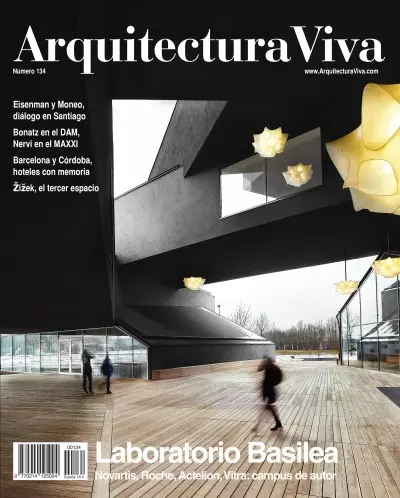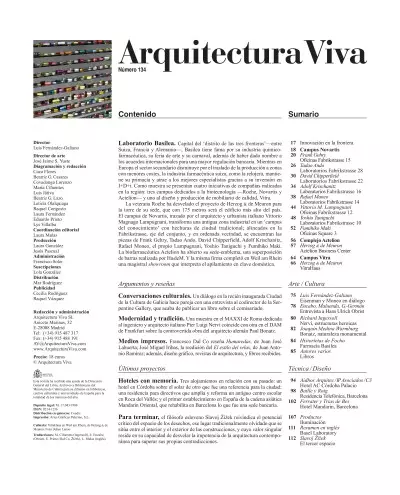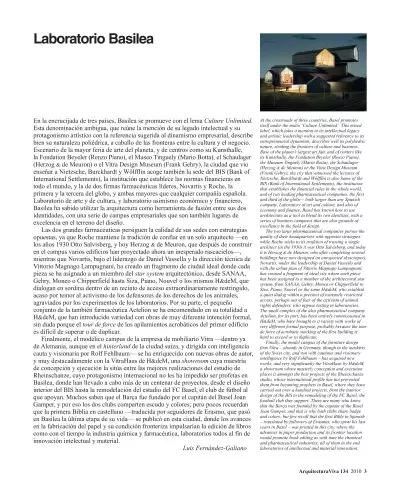Synopses
Lab Basel. Capital of the ‘three frontier region’ – between Switzerland, France and Germany –, Basel is famous for its chemical and pharmaceutical industry, its art fair and its carnival, aside from having lent its name to the main international accords for banking supervision. While in?Europe the secondary sector decreases because of the outsourcing of production to areas with fewer costs, the Swiss pharmaceutical industry, like the watchmaking one, stays in the lead and attracts the best specialists thanks to its investment in research, development and innovation. Included here are four initiatives of companies based in the area:?three campuses devoted to biotechnology – Roche, Novartis and Actelion – and one to furniture design and manufacturing, Vitra.
The veteran company Roche has unveiled the project designed by Herzog & de Meuron for its new headquarters, a tower that will be the country’s tallest with its 175 meters. The Novartis Campus, planned by the architect and urbanist Vittorio Magnago Lampugnani, transforms an old industrial area into a ‘knowledge campus’ inspired by the traditional city; orderly aligned on Fabrikstrasse, the axis of the complex, rise the works by Frank Gehry, Tadao Ando, David Chipperfield, Adolf Krischanitz, Rafael Moneo, Lampugnani himself, Yoshio Taniguchi and Fumihiko Maki. The biopharmaceutical company Actelion has opened its emblem-headquarters, a series of superimposed bars carried out by H&deM. And the same team completed in Weil am Rhein a masterly showroom that interprets stacking in domestic key.
Contents
Innovation at the Frontier
Novartis?Campus
Frank Gehry
Offices Fabrikstrasse 15
Tadao Ando
Laboratories Fabrikstrasse 28
David Chipperfield
Laboratories Fabrikstrasse 22
Adolf Krischanitz
Laboratories Fabrikstrasse 16
Rafael Moneo
Laboratories Fabrikstrasse 14
Vittorio M. Lampugnani
Offices Fabrikstrasse 12
Yoshio Taniguchi
Laboratories Fabrikstrasse 10
Fumihiko Maki
Offices Square 3
Actelion?Complex
Herzog & de Meuron
Actelion Business Center
Vitra Campus
Herzog & de Meuron
VitraHaus
Views and Reviews
Cultural Conversations. A dialog in the recently inaugurated City of Culture of Galicia pairs up with an interview with the co-director of the Serpentine Gallery, who has just published a book about curatorship.
Art / Culture
Luis Fernández-Galiano
Eisenman and Moneo in Dialog
Encabo, Maluenda, G.-Germán
Hans Ulrich Obrist Interview
Modernity and Tradition. An exhibition at Rome’s MAXXI devoted to the Italian engineer and architect Pier Luigi Nervi coincides with another one at Frankfurt’s DAM on the polemic oeuvre of the German architect Paul Bonatz.
Richard Ingersoll
Nervi, Heroic Structures
Joaquín Medina Warmburg
Bonatz, Monumental Nature
Printed Media. Francesco Dal Co reviews Humaredas, by Juan José Lahuerta; José Miguel Iribas, the reedition of El estilo del relax, by Juan Antonio Ramírez; moreover, graphic design, architecture magazines, and books received.
Fochos Cartoon
Pharmacy Basel
Various Authors
BooksRecent Projects
Hotels with Memory. Three accommodations in touch with their past: a hotel in Córdoba on the site of another one which used to be a city landmark; a residence for executives that extends and refurbishes an old school in Roca del Vallès; and the first Spanish branch of the Asian hotel group Mandarin Oriental, which refurbishes in Barcelona what used to be a bank headquarters.
Technique / Style
Aidhos/IP Asociados/C3
Hotel AC Córdoba Palacio
Batlle & Roig
Telefónica Residence, Barcelona
Ferrater & Trias de Bes
Mandarin Hotel, Barcelona
To close, the Slovenian philosopher Slavoj Žižek asserts the critical potential of the space of waste, that traditionally neglected place that is located between the interior and the exterior of buildings, and the unique value of which resides in its capacity to reveal the inability of contemporary architecture to overcome its own contradictions.
Products
Lighting
English Summary
Lab Basel
Slavoj Žižek
The Third Space
Luis Fernández-Galiano
Lab Basel
At the crossroads of three countries, Basel promotes itself under the motto ‘Culture Unlimited’.?This mixed label, which joins a mention to its intellectual legacy and artistic leadership with a suggested reference to its entrepreneurial dynamism, describes well its polyhedric nature, striding the frontiers of culture and business. Base of the planet’s largest art fair, and of centers like its Kunsthalle, the Fondation?Beyeler (Renzo Piano), the Museum Tinguely (Mario Botta), the Schaulager (Herzog & de Meuron)?or the Vitra Design?Museum (Frank Gehry), the city that witnessed the lectures of Nietzsche, Burckhardt and Wölfflin is also home of the BIS?(Bank of International?Settlements), the institution that establishes the financial rules in the whole world, and of two leading pharmaceutical companies, the first and third of the globe – both larger than any Spanish company. Laboratory of art and culture, and also of economy and finance,?Basel has known how to use architecture as a tool to blend its two identities, with a series of business campuses that are also grounds of excellence in the field of design.
The two large pharmaceutical companies pursue the quality of their headquarters with opposite strategies: while Roche sticks to its tradition of trusting a single architect (in the 1930s it was Otto Salvisberg, and today it is Herzog & de Meuron, who after completing several buildings have now designed an unexpected skyscraper), Novartis, under the leadership of Daniel?Vassella and with the urban plan of Vittorio Magnago Lampugnani, has created a fragment of ideal city where each piece has been assigned to a member of the architectural star system, from SANAA, Gehry, Moneo or Chipperfield to Siza,?Piano, Nouvel or the same H&deM, who establish a quiet dialog within a precinct of extremely restricted access, perhaps out of fear of the activism of animal rights defenders, who oppose testing in laboratories. The small complex of the also pharmaceutical company?Actelion, for its part, has been entirely commissioned to H&deM, who have brought to it variety with works of very different formal purpose, probably because the tour de force of acrobatic stacking of the first building is hard to exceed or to duplicate.
Finally, the model campus of the furniture design firm Vitra – already in Germany, though in the outskirts of the Swiss city, and run with cautious and visionary intelligence by Rolf?Fehlbaum – has acquired new works, and very significantly the VitraHaus by H&deM, a showroom whose masterly conception and execution places it amongst the best projects of the Rheinschanze studio, whose international profile has not prevented them from becoming prophets in?Basel, where they have carried out over a hundred projects, from the interior design of the BIS?to the remodeling of the FC?Basel, the football club they support. There are many who know that the Barça was founded by the captain of the Basel Joan Gamper, and that is why both clubs share badge and colors; but few recall that the first Bible in Spanish – translated by followers of Erasmus, who spent his last years in Basel – was printed in this city, where the advances in paper production and its frontier location would promote book editing as with time the chemical and pharmaceutical industries, all of them in the end laboratories of intellectual and material innovation.








